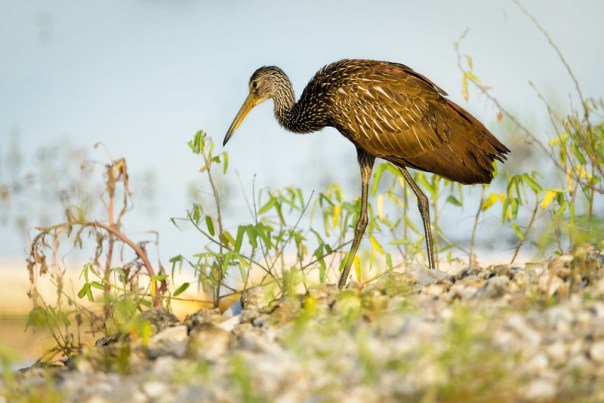Four of us from the Photography Interest Group went to Viera Wetlands last Saturday. On the way, we stopped by Riverfront Park on the Indian River at SR 520 in Cocoa for sunrise.
There weren’t many clouds, but with a longer lens than I normally use (120mm equivalent instead of an ultra wide-angle), I managed to place this boat in the frame against a background of clouds and the causeway bridge. The colors on the water are nice and I was happy with the result.
As we left, I saw what looked like a sunken boat out of the corner of my eye to the south of where we’d been photographing. Since the good light was fading, and everyone else was ready to leave for Viera, I didn’t get a chance to check it out at the time.
For some reason, sunken / abandoned boats really appeal to me as photographic subjects. Maybe it’s because I spent time in the Navy. They seem sad and make me wonder what happened and why. This one nagged at me, and I really wanted to explore it so I decided to drive back over on Wednesday to see what I’d missed. Many times the boat gets salvaged – so if you don’t photograph it when you find it, you may not get a second chance.

A dream, gone – in the harbor at dawn.
Luckily the boat was still right where I’d seen it. I found a spot where I could use the sailboat mast reflections to outline the sunken hull and place it between the blue and orange colors mirrored on the water. I like the first photo, but I think this second one is stronger.
If we’d taken the time to explore this on our first visit, would I have gotten as strong a photo? Did I get a better photo on my second trip because I was by myself? Is photography essentially a solo activity?
Cue the standard photography answer: “It depends.” I believe you need to be “in the zone” to make great photos. Distractions and / or fellow photographers can hinder concentration – or they can point you in the right direction. When you’re with a group you also have to compromise and go along – you can’t do everything you want and force everyone else to do it too. If you’re mainly a landscape photographer, going photographing with someone really into bird photography may not help your landscape images. Or it might – birds hang out in some beautiful places.
If you go with people more experienced / knowledgable than you are, you may learn a bit and make better images as a result. Or you may find out about new places that they know but you don’t. Or you might even open your eyes to a different way of seeing something. If you’ve ever been out photographing with a group, you know there will be many similar images. But there will also be some that look completely different even though two photographers stand right next to each other.
I looked through my most interesting images (according to Flickr, anyway). Of the first 20, 10 were when I was by myself and 10 when I was with other photographers. Conclusive numerical evidence, eh?
So to answer the question in the title of this post: Is photography a solo or a group activity? Yes. You’ll be a better photographer if you go photographing both by yourself and in groups. Mix it up and take advantage of both ways to enjoy and improve your photography.
By the way, we did make it to Viera Wetlands. We saw many of the usual animals in the main area including Hawks, Ospreys, Great Blue Herons, Little Blue Herons, Green Herons, Snowy and Great Egrets, Grebes, Black Bellied Whistling Ducks, Alligators, Turtles, etc. We saw a few more species in the Click Ponds: White Pelicans, Sandpipers, Roseate Spoonbills, and Woodstorks. A nice visit.

Sandpiper flock and reflections
Thanks for stopping by and reading my blog. Now – go make some photos – alone and in a group!
©2013, Ed Rosack. All rights reserved
























